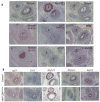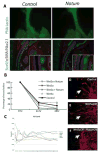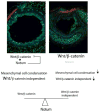Notum attenuates Wnt/β-catenin signaling to promote tracheal cartilage patterning
- PMID: 29428562
- PMCID: PMC5889736
- DOI: 10.1016/j.ydbio.2018.02.002
Notum attenuates Wnt/β-catenin signaling to promote tracheal cartilage patterning
Abstract
Tracheobronchomalacia (TBM) is a common congenital disorder in which the cartilaginous rings of the trachea are weakened or missing. Despite the high prevalence and clinical issues associated with TBM, the etiology is largely unknown. Our previous studies demonstrated that Wntless (Wls) and its associated Wnt pathways are critical for patterning of the upper airways. Deletion of Wls in respiratory endoderm caused TBM and ectopic trachealis muscle. To understand mechanisms by which Wls mediates tracheal patterning, we performed RNA sequencing in prechondrogenic tracheal tissue of Wlsf/f;ShhCre/wt embryos. Chondrogenic Bmp4, and Sox9 were decreased, while expression of myogenic genes was increased. We identified Notum, a deacylase that inactivates Wnt ligands, as a target of Wls induced Wnt signaling. Notum's mesenchymal ventral expression in prechondrogenic trachea overlaps with expression of Axin2, a Wnt/β-catenin target and inhibitor. Notum is induced by Wnt/β-catenin in developing trachea. Deletion of Notum activated mesenchymal Wnt/β-catenin and caused tracheal mispatterning of trachealis muscle and cartilage as well as tracheal stenosis. Notum is required for tracheal morphogenesis, influencing mesenchymal condensations critical for patterning of tracheal cartilage and muscle. We propose that Notum influences mesenchymal cell differentiation by generating a barrier for Wnt ligands produced and secreted by airway epithelial cells to attenuate Wnt signaling.
Copyright © 2018 Elsevier Inc. All rights reserved.
Figures










References
-
- Ayers KL, Mteirek R, Cervantes A, Lavenant-Staccini L, Therond PP, Gallet A. Dally and Notum regulate the switch between low and high level Hedgehog pathway signalling. Development. 2012;139:3168–3179. - PubMed
-
- Boogaard R, Huijsmans SH, Pijnenburg MW, Tiddens HA, de Jongste JC, Merkus PJ. Tracheomalacia and bronchomalacia in children: incidence and patient characteristics. Chest. 2005;128:3391–3397. - PubMed
Publication types
MeSH terms
Substances
Grants and funding
LinkOut - more resources
Full Text Sources
Other Literature Sources
Molecular Biology Databases
Research Materials

